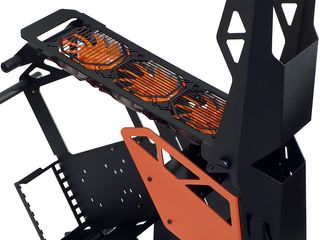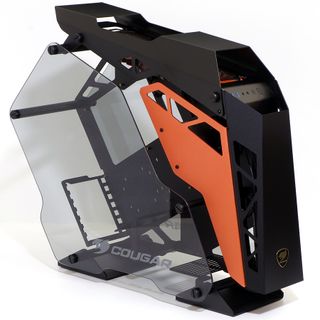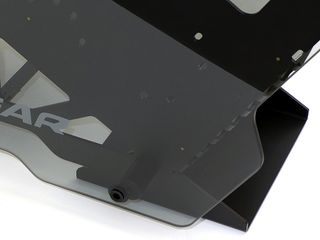Early Verdict
The Cougar Conquer performs so well that show builder systems probably shouldn’t immediately be discouraged by our sample’s single defect, but should instead follow up by reading customer reviews.
Pros
- +
Extreme cooling performance
Cons
- -
No Dust Filtration
- -
Our sample had a single major defect
Why you can trust Tom's Hardware
Features & Specifications
Ah, the process of standardization. Standardization allows people to put any ATX motherboard in any ATX case, and the one way that can go wrong is if one of those two items violates the form factor. When it comes to motherboards, the term “form factor” is so specific that a buyer need not question anything. It’s the reason I’ve removed the term “small form factor” from so many articles: We need to know what fits! So if “Mid Tower” isn’t a form factor, what is it? A style? Cougar is the latest company to blur the lines in an open-air chassis that fits into either the “Mid Tower” or “Full Tower” category, depending on where it’s measured.
An open platform that doesn’t have so much as a back panel, the Conquer has enough interior space to fit an EATX motherboard but no mechanical support for full-spec (13”) models, and some of the rest depends on fan and radiator placement, which all turns into a complicated series of calculations given its non-rectangular interior. More important is that the case fits most gaming hardware, including those ~10.6” boards that so often carry the EATX label and can even hold a graphics card up to 15” long with its drive tray installed.
Specifications
Features




Tom’s Hardware doesn’t usually favor unboxing photos, but the Cougar’s unusual packaging is worth a look since it arrives unassembled. Builders are left to peel back the layers to reveal additional pieces.

Those pieces include three fans with grills, several adhesive cable ties and tabs, several screw packs, two feet, a power supply bracket and tray, a drive tray that supports either two 2.5” or one 3.5” drive, and five cross braces. Two more 2.5” or 3.5” drives can be mounted to the back of the motherboard tray prior to motherboard installation.

The Conquer top panel supports 2x 120mm radiators up front and 3x 120mm on top, and the upper structural panel opening is large enough to feed through hose fittings from above, if desired. Since the chassis includes three fans, we placed these there.

The drive tray fits just inside of the upper portion of the red panel, and drives can be mounted on either side. The power supply mounting bracket can be slid forward to alternative mounting holes to get it closer to the slot-vented support shelf, if desired.

Though lighting is the obvious difference, our image of the assembled Conquer also differs from the one prepared by Cougar in that we’ve installed the standoffs, fan grills, and power supply mounting bracket, in addition to the power supply support shelf.

The three dots on the promotional photo’s front-panel port section are also missing from this production case. Users get two USB 3.0 ports, headphone and microphone jacks, a reset button with an HDD activity LED in its center, and a power button with a power-on LED in its center.

Unlike the red shroud of the left side, the right flank is part of the motherboard tray and face panel and thus gets the black treatment. If you’re wondering why it’s missing one of its five screws . . . .

We didn’t install the last screw because its hole was cut in the wrong place. Checking all the measurements didn’t help, and everything was straight, but comparing the left panel to the right proved that this was nothing other than an unusual manufacturing defect. Cougar would have replaced the glass for us, but that wasn’t needed to complete today’s analysis since its rubber cushion pressed firmly against the stand that it was supposed to be screwed onto (hence the defect caused no additional vibration).
MORE: Best Cases
MORE: All Case Content
-
rtrski Could you please clarify about the 'could fit EATX motherboard but no support'? (Paraphrasing). I've seriously considered re-housing my current build into this case with the one exception being I have the MSI X-power AC EATX motherboard, and all the specs for the case promise only ATX compatibility. A couple missing standoffs alone wouldn't be enough to stop me...just have to support the backside when plugging in things like CPU, RAM, etc. But if it physically interferes with getting the case built, that's another story of course.Reply -
rtrski Sorry, I should have been more specific. MSI X99S X-power AC from Haswell-E/Broadwell-E days, dimensions are 12"x10.7".Reply -
Crashman Reply
To be clear, your board will fit this chassis, and the chassis has all the standoffs for your board. Likewise, your board isn't actually EATX, it's a prioprietary depth in between ATX and EATX. It's only about an inch deeper than ATX, and far less than the 13"-deep EATX specification. Take a look:20695485 said:Could you please clarify about the 'could fit EATX motherboard but no support'? (Paraphrasing). I've seriously considered re-housing my current build into this case with the one exception being I have the MSI X-power AC EATX motherboard, and all the specs for the case promise only ATX compatibility. A couple missing standoffs alone wouldn't be enough to stop me...just have to support the backside when plugging in things like CPU, RAM, etc. But if it physically interferes with getting the case built, that's another story of course.
You can clearly see that there's around 3" of extra space in front of the board, at the closest corner
Here is an EATX board, with the extra standoffs:
The reason for these lengthy discussions is that a case must support the above board to be labeled fully EATX compliant, and must have standoffs 12.7" forward of the rear edge. Since a 10.7"-deep board doesn't cover those extra standoffs, it doesn't need those extra standoffs. -
antishill What is with all these oversized giant cases. Price too high, too big, and generally pointless.Reply -
rtrski Thanks very much, Crashman!Reply
Now I just have to figure out if I can mod in an optical disk easily, since I'm a Luddite that still wants one. (Yes, misuse of Luddite. ;-P ) If nothing else just use an external and place it underneath that center gap between the case legs with the tray turned sideways. -
milkod2001 Looke very sexy yes but in a few months time dust will kill it inside, who is going to clean it all the time?Reply -
modusoperandi00 Pah! Back in my day, we liked our cases like we liked our women; closed-off and rectangular!Reply -
JamesSneed You know what they say beauty is in the eye of the beholder and this eye thinks this case looks like junk. Course the terrible noise levels and no dust filters just add to the no thank you column from me. Thanks for reviewing it i'm sure some people will like a case geared 100% to cooling that has this funky look to it.Reply

